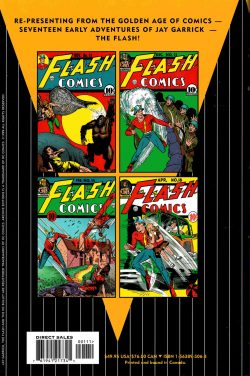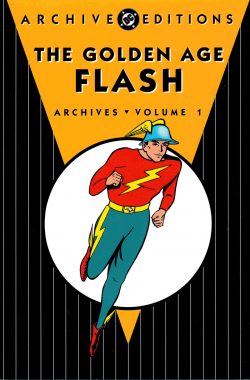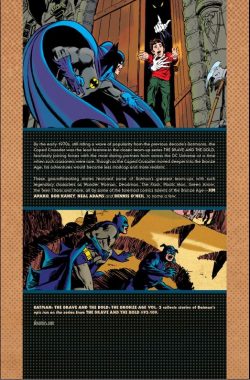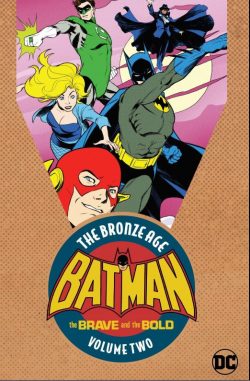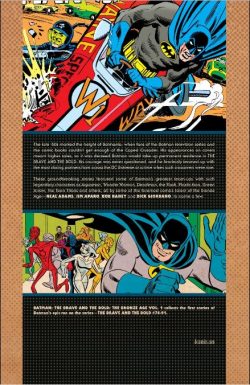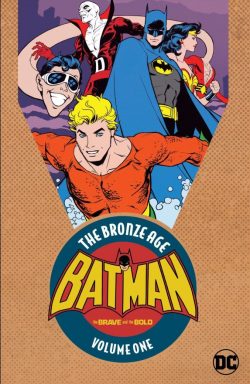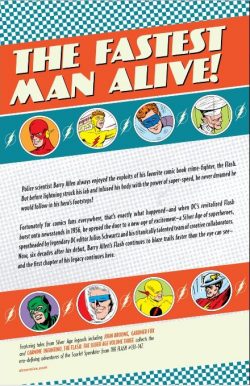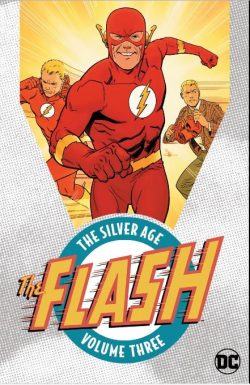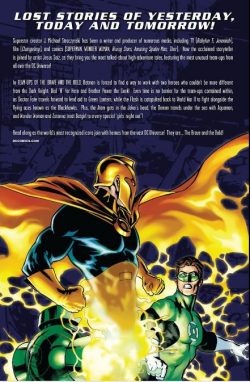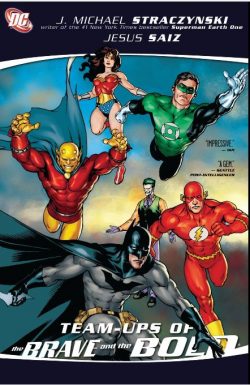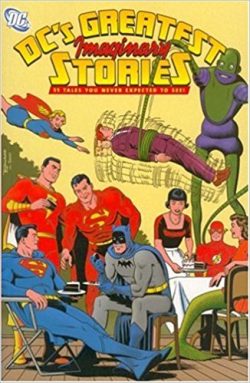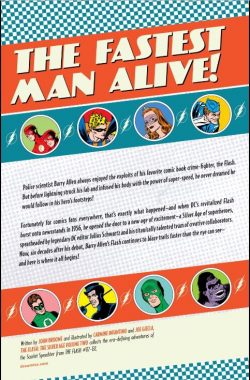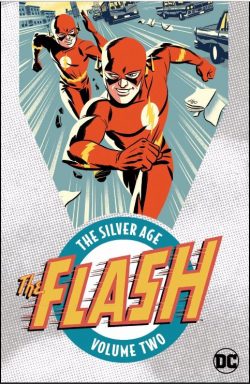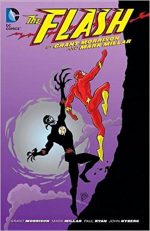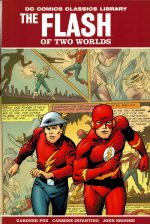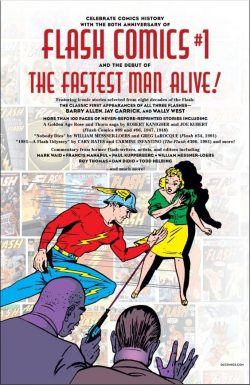
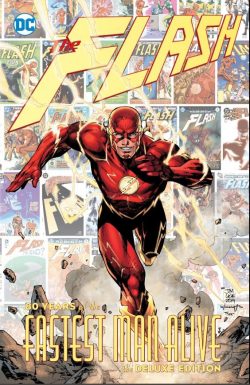
By Gardner F. Fox, Robert Kanigher, John Broome, Cary Bates, William Messner-Loebs, Mark Waid, Mark Millar & Grant Morrison, Geoff Johns, Francis Manapul & Brian Buccellato, Joshua Williamson, Gail Simone, Harry Lampert, Joe Kubert, Carmine Infantino, Alex Saviuk, Greg LaRocque, Mike Wieringo, Paul Ryan, Scott Kolins, Neil Googe, Clayton Henry & various (DC Comics)
ISBN: 978-1-4012-9813-5 (HB)
The Flash was the first specialist superhero in comics. He was the blessed by only one extra-normal power yet started a trend and inspired a wave of imitators.
Jay Garrick debuted as the very first Scarlet Speedster in Flash Comics #1 (January 1940) and  “The Fastest Man Alive†wowed readers for over a decade before changing tastes benched him in 1951. After a period of unremarkable he-men dominated comics pages for half a decade, the concept of speedsters, and indeed, superheroes in general were revived in 1956 by Julie Schwartz in Showcase #4 where and when police scientist Barry Allen became the second hero to run with the concept.
The Silver Age Flash, whose creation and subsequent stellar run ushered in a new and seemingly unstoppable era of costumed crusaders, died heroically during Crisis on Infinite Earths (1985-1986). He was promptly succeeded by his sidekick Kid Flash. Of course, Allen later returned from the dead, but doesn’t everyone, eventually?
There have been many super-speedsters in the DCU and most of them congregate in the conjoined metropolis of Keystone and Central City. As Kid Flash/Flash, Wally West – chronologically the third official incarnation – lived there with his true love Linda Park, his Aunt Iris (Barry Allen’s widow) and fellow fast-fighters such as Jay Garrick. Impulse (juvenile speedster Bart Allen from the future, who also became a/The Flash) and his mentor/keeper Max Mercury – the Zen Master of hyper-velocity – lived in Alabama, but often visited as they only were picoseconds away…
A true icon of the industry and art form, The Flash is synonymous with superb comics storytelling and this splendid collection – available as a bonanza hardback and in various digital formats – offers curated material from Flash Comics#1, 89, 96, Showcase #4, The Flash #106, 110, 123, 155, 275, 300, Flash #54, 91, 133, 182, The Flash #0, DC Comics Holiday Special 2017 and The Flash Giant #2, celebrating a concept as much as the heroes who serially embodied it. The stories span January 1940 to February 2019 and are augmented by a succession of essays and articles, beginning with an Introduction by Dan Didio, before sprinting head first into the first milestone.
Created and crafted by Gardner F. Fox & Harry Lampert, ‘The Origin of the Flash’ appeared in and headlined anthology Flash Comics #1, which also introduced Hawkman and Johnny Thunder amongst others. The fast-paced first feature reveals how over-achieving physics student Garrick is exposed to “hard water fumesâ€. After initially putting him in a coma, the accident gives him super-speed, reactions and endurance. The breezy tale speedily delivers an origin, a returning cast and a classic confrontation with sinister syndicate the Faultless Four and their diabolical leader Sieur Satan.
Essay ‘Flash of Two Whirls’ by Roy Thomas then details Garrick’s career with a canny concentration on psychologically-framed arch enemy The Thorn. She was a plant-themed villain who hid within an innocent and demure split personality called Rose, who only had two published appearances. A third “lost†adventure completes the comics section, then  follows one of many unpublished episodes shelved by the abrupt decline of superheroes at the end of the 1940s. How and why so much material was saved is also revealed in Thomas’ treatise before the action resumes with ‘Introducing the Thorn: The Flash’s Newest Opponent’.
Cover-dated November 1947, Flash Comics #89, the lead story was crafted by Robert Kanigher & Joe Kubert and detailed how a vicious, sexy criminal rampaged across the city pursued by the hero and her “sisterâ€. Sporting a far more refined outfit, she resurfaced in Flash Comics #96 (June 1948, Kanigher & Kubert) threatening Keystone in ‘The Flash and the Thorn-Stalk’, before once again apparently perishing.
Seen here in stark monochrome, again by Kanigher & Kubert, ‘Strange Confession’ sat in a draw unpublished since 1948 until rescued by Marv Wolfman. Now it completes a trilogy of epic psycho-dramas as Rose and the Thorn battle the Fastest Man Alive again before being apparently cured by the intervention of the Justice Society of America…
‘A Flash of Inspiration’ by Paul Kupperberg then sets the scene for the Allen Age of Comics…
No matter which way you look at it, the Silver Age of the American comic book began with The Flash. It’s an unjust but true fact that being first is not enough; it also helps to be best and people have to notice. MLJ’s The Shield beat Captain America to the newsstands by over a year, yet the former is all but forgotten today.
America’s comicbook industry had never really stopped trying to revive the superhero genre when Showcase #4 was released in late summer of 1956 (cover-dated October). The newsstands had already been blessed – but were left generally unruffled – by such tentative precursors as The Avenger (February-September 1955), Captain Flash (November 1954-July 1955) and a revival of Marvel’s Human Torch, Sub-Mariner and the aforementioned Captain America between December 1953 and October 1955.
Both DC’s own Captain Comet (December 1953-October 1955) and Manhunter from Mars (November 1955 until the end of the 1960’s and almost the last days of superheroes again!) had come and made little mark. What made the new Fastest Man Alive stand out and stick was … well, everything!
Once DC’s powers-that-be decided to seriously attempt superheroes once more, they moved pretty fast themselves. Editor Julie Schwartz asked office partner, fellow editor and Golden-Age Flash scripter Robert Kanigher to recreate a speedster for the Space Age, aided and abetted by Carmine Infantino and former flash artist Joe Kubert.
The new Flash was a forensic scientist simultaneously struck by lightning and bathed in exploding chemicals from his lab. Supercharged by the accident, Barry Allen cheekily took his superhero identity from an old comic book featuring his (at that time “fictionalâ€) predecessor Jay Garrick. Designing a sleek, streamlined bodysuit (courtesy of Infantino – a major talent rapidly approaching his artistic and creative peak), Barry became point man for the spectacular revival of a genre and an entire industry.
From his spectacular run comes the pivotal event which marked the beginning of a way of life for so many addicted kids. Written by Kanigher, pencilled by Infantino and inked by Kubert, Showcase #4’s ‘Mystery of the Human Thunderbolt!’was another quick-fire origin with crime story attached as the brand-new hero discovers his powers and mission and still finds time to defeat a modern iteration of the Turtle – a criminal mastermind dubbed “the Slowest Man Alive!â€.
Following his meteoric launch in Showcase #4, the Flash was uncharacteristically slow in winning his own title, but finally (after three more cautiously released trial issues) finally stood on his own wing-tipped feet in The Flash #105 (February-March 1959 – so it was out for Christmas 1958). John Broome and Gardner Fox would write the bulk of the early tales, introducing a “big science†sensibility and – courtesy of Broome – an unmatched Rogues Gallery of fantastic foes which would become the template for all proper superheroes.
Crafted by John Broome, Infantino & Joe Giella, ‘Menace of the Super-Gorilla!’ comes from The Flash #106 (May 1959). It was the second story (behind the Pied Piper‘s debut) and introduces one of the most charismatic and memorable baddies in comics history. Gorilla Grodd and his hidden race of super-simians debuted here – promptly returning for the next two issues – in a cunning yarn as the ultra-advanced ape invades the human world in search of the greatest mind on Earth, which he intends to subjugate for his own nefarious purposes…
Presumably this early confidence was fuelled by DC’s inexplicable but commercially sound pro-Gorilla editorial stance (for some reason any comic with a big monkey in it markedly outsold those that didn’t in those far-ago days), but these tales are also packed with tension, action and engagingly challenging fantasy concepts.
Next up is another landmark: two in fact…
The Flash #110 (January 1960) was a huge hit, not so much for the debut of another worthy candidate to the burgeoning Rogues Gallery in ‘The Weather Wizard’ but rather for the introduction of Wally West, who in a bizarre and suspicious replay of the lightning strike that created the Scarlet Speedster became a junior version of the Fastest Man Alive. Broome, Infantino & Giella’s ‘Meet Kid Flash!’ introduced the first sidekick of the Silver Age (cover dated December 1959-January 1960 and just pipping Aqualad who premiered in Adventure Comics #269 which had a February off-sale date). Not only would Kid Flash begin his own series of back-up tales from the very next issue (a sure sign of the confidence the creators had in the character) but he would eventually inherit the mantle of the Flash himself – one of the few occasions in comics where the torch-passing actually stuck…
Super-Editor Schwartz guaranteed a new epoch with his Showcase successes Flash, Adam Strange and Green Lantern, which directly led to the Justice League of America – and even more revivals. This in turn inspired Fantastic Four and the whole Marvel Empire, which changed the way comics were made and read…
Whereas 1940s tales were about magic and macho, the Silver Age varnished everything with a thick veneer of SCIENCE and a wave of implausible rationalistic concepts quickly filtered into the dawning mass-consciousness of a generation of baby-boomer kids. The most intriguing and rewarding was, of course, the notion of parallel worlds: the very crux of this celebration and a prime component of most modern fantasy serials in books, film, TV and comics.
The continuing adventures of the Scarlet Speedster became the bedrock of the Silver Age Revolution. After ushering in the triumphant return of the costumed superhero concept, the Crimson Comet – with Broome and Fox at the reins – set an unbelievably high standard for superhero adventure in sharp, witty tales of technology and imagination, illustrated with captivating style and clean simplicity by Infantino.
Fox didn’t write many Flash scripts at this time, but the few he did were all dynamite; none more so than the full-length epic which literally changed the scope of American comics forever.
‘Flash of Two Worlds’ (The Flash #123, September 1961 and inked by Giella) introduces the concept of alternate Earths to the continuity. The idea grew by careful extension into a multiversal structure comprising Infinite Earths. Once established as a cornerstone of a newly integrated DCU through a wealth of team-ups and escalating succession of cosmos-shaking crossover sagas, a glorious pattern was set which would, after joyous decades, eventually culminate in a spectacular Crisis on Infinite Earths…
During a benefit gig Flash accidentally slips into another dimension where he finds the comic book hero upon whom he based his own superhero identity actually exists. Every ripping yarn he had avidly absorbed as an eager child was grim reality to Jay Garrick and his comrades on the controversially designated “Earth-2â€. Locating his idol, Barry convinces the elder to come out of retirement just as three Golden Age villains make their own criminal comeback…
The floodgates were opened, and over the following months and years many Earth-1 stalwarts met their counterparts either via annual collaborations in the pages of Justice League of America or in their own series. Schwartz even had a game go at reviving a cadre of the older titans in their own titles. Public approval was decidedly vocal and he used DC’s try-out magazines to take the next step: stories set on Earth-2 exclusively featuring Golden Age characters, but of those bold sallies, only The Spectre briefly graduated to his own title…
When the Scarlet Speedster wasn’t boggling minds he was furiously fighting the best villains in comics. The inevitable had to happen – and finally did – in The Flash #155 (September 1965) when Broome teamed six of the Rogue’s Gallery into ‘The Gauntlet of Super-Villains!’: a bombastic Fights ‘n’ Tights extravaganza, but one with a hidden twist and a mystery foe concealed in the wings…
As tastes changed, The Flash evolved with them and survived the early 1970s downturn in superhero storytelling, but nobody was prepared for a truly big shock. When Cary Bates, Alex Saviuk & Frank Chiaramonte held ‘The Last Dance’in #275 (July 1979), it heralded the end of an era when comfortable married Barry was unable to prevent the murder of his beloved Iris by a truly insane enemy…
No, that’s not a spoiler. She came back. They always do: it’s just that nobody knew that back then and it did take decades to undo the evil act…
In the meantime, Barry moved on and began life as a widowed singleton. Anniversary epic The Flash #300 (August 1981, Bates, Infantino & Bob Smith) featured ‘1981- A Flash Odyssey’ comprising a deft recapitulation of his life and career, all wrapped up in a cunning and sadistic scheme to drive him mad perpetrated by his most vicious foe…
‘The Flash – A.K.A. Wally West’ by William Messner-Loebs ushers in the era of the third Flash as the DCU underwent a radical reboot during Crisis on Infinite Earths. Initially Wally West struggled to fill the boots of his predecessor, both in sheer ability and, more tellingly, in confidence. Feeling a fraud, he nonetheless persevered and eventually overcame, becoming the greatest to carry the name. Typifying that highly-engaging transition period comes ‘Nobody Dies’ (Flash #54 September 1991) by Messner-Loebs, Greg LaRocque & José Marzán Jr., focussing on the intricacies of the speedster’s powers as his hyper-fast abilities – and their limits – are tested whilst trying to save a flight attendant plunging from a aircraft…
Mark Waid discusses the hero’s ‘Legacy’ before ‘Out of Time’ from Flash #91 (June 1994) expands the dilemma of how much even the most powerful man can do in a classic mind-boggler by Waid, Mike Wieringo & Marzán Jr.
Towards the end of the 1990s the grand, old-fashioned Fights ‘n’ Tights mythology and methodology was given a bit of post-modern gloss when Caledonian wizards Grant Morrison and Mark Millar turned their considerable talents to Wally West incarnation of the Fastest Man Alive. In Flash #133 (cover-dated January 1998), the Celtic lads showed American writers how it’s all pronounced when Scottish legacy villain Mirror Master attacks a wounded and recuperating hero: abducting his bride-to-be Linda in ‘Flash Through the Looking Glass’. Illustrated by Paul Ryan & John Nyberg, the story features a spectacular race against time to prevent her de-aging out of existence and is followed by a memorable contribution from Geoff Johns, Scott Kolins & Dan Panosian. ‘Absolute Zero’ (Flash #182, March 2002) delves deep into the frosty psyche of arch rogue Len Snart as the chilling Captain Cold goes looking for the killer of his little sister Lisa…
Reboots are an inescapable hazard of modern comics as publishers periodically seek to make old soldiers fresh and palatable to an ever-changing readership. In 2011 DC used the Flashpoint publishing event to restart their entire continuity in a project dubbed The New 52. As always, the result was instant attention-grabbing from the press but mixed results for the fans. The Flash weathered the change better than most and a new, younger Barry Allen returned to the streets of his city to start his career all over again.
Crafted by Francis Manapul and lettered by Steve Wands, ‘First Step’ offers a potent painted picture spread introducing the new-old vizier of velocity and is followed by a rehashed origin in Manapul & Brian Buccellato’s ‘Before the New 52’from The Flash #0: released in November 2012, a year after the big change.
TV Flash scripter Todd Helbing describes ‘The Impossible’ before we hit the final stretch with delightful and evocative short tale ‘Hope for the Holidays’ by Joshua Williamson & Neil Googe – taken from DC Holiday Special December 2017 and with Scarlet Speedster playing Christmas spirit – before The Flash Giant #2 (February 2019) provides ‘Get Out of the Kitchen’ by Gail Simone, Clayton Henry, reintroducing classic Rogue Mick Rory as a far nastier Heatwave.
Closing this immense commemorative tome comes Cover Highlights celebrating each era – the Golden, Silver, Bronze, Dark and Modern Ages – with a selection of unforgettable front images and a full roster of Biographies celebrating the many artist and writers who have passed on the baton since 1940.
One of the most revered comics heroes of all time, The Flash has probably been all things to most people in his/their time. Always exciting and never a waste of time, the hero is one no fan of the basics should miss. Why not try them all? It’s a marathon, not a sprint, right?
© 1940, 1947, 1948, 1956, 1959, 1960, 1961, 1965, 1979, 1981, 1991, 1994, 1998, 2002, 2012, 2017, 2019 DC Comics. DC Comics. All Rights Reserved.
